The Oval Synthesizer
Starting with a baby toying with the stereo’s volume and tuning knobs, the author attempts to recuperate a mysterious oval synth, with two giant knobs, catered to “pre-lingual” gestures. He describes two new instruments that process torque gestures, using nobs, or non-knobs, that allow intuitive exploration. The surfing metaphor is appropriate because an oval synthesizer looks like a surfboard, but also because of the intuition involved in exploring waveforms. The oval form factor offers new pockets for interface design and an exercise in creative branding.
The Pre-Lingual Gesture
This story has multiple foci. It first curves about when my baby 1[1. Aestus Kirito Kataoka Blasser, born 2010.] stood up to investigate the stereo — the one my father left me, a 1950s solid-state model with two large knobs for volume and tuning. When Kiri discovered it, he grabbed both knobs and twisted them back and forth. At first, the transition from cool jazz to loud static startled him, but he often returned with the expectation of great and chaotic sonic effect, and the tactile pleasure of “milking” the large metal knobs.
The milking gesture derives from a wonderful motor moment of early childhood: mirrored muscles. The nerve impulses for torque gestures, such as grab and twist, involuntarily transmit to both hands simultaneously. Thus a clockwise twist on the left hand manifests an equal and opposite, counter-clockwise twist on the right hand. Adult knob usage only thinks in parallel intensities, usually with the clockwise motion meaning “increasing”. The baby’s milking gesture, however, balances both clockwise and counter-clockwise motion as equals.
We obsessively tune our everyday apparatus, taking this balance for granted until confronted with a young one’s radical milking gestures. The knobs of my father’s stereo were for a static registration of hi-fidelity preferences, whereas Kiri re-purposed them for dynamic play-movement and change instead of precision and planning.
As a father, I train my child to not push my buttons or tweak a radio into distortion; as a synthesynthesist 2[2. Synthesynthesist simply means “one who synthesizes synthesizers,” as in a builder or designer of those devices. Note the recursivity of this neologism; this post-transistor activity involves fiction, science fiction and world-making.], I attend to technology performances and capitalize on alternative gestures. A lingual use of the dial enforces a semiotic structure of named parameters, such as “volume” or “tuning”, but Kiri’s milking gesture focused on the knob-as-knob — a physical thing to grab and twist. This pre-lingual knob interests me; having no defined function, it offers a solution to the non-playing 3[3. Miles Davis uses the term “non-playing” to describe peripheral or inferior musicians (Davis and Troupe 1989, 83 and 301). Not to disrespect precision and tuning, but to differentiate it from playing and performing, a synthesizer should elevate musicality rather than drag it down.] doldrums of structured synthesis — technicalities, tuning obsessions and goals that leave improvisation by the wayside. Instead, I define the “nob” a non-knob, unknown but performative, that pulls its human subject to intuit and explore. 4[4. Functional words mark an instrument’s knobs, such as volume or pitch. One knows not what a nob does, though.],
Din Datin Dudero
Din Datin Dudero. The oval manifesto instrument, with two large and furry nobs, a forest of sandrodes, and a sh’mance.
Sandrodes. Androgynous nodes that represent both input and output. Inter-sandrodes bring forth the very innards of analogue process cells, while intra-sandrodes arise from connections (modulations) between larger blocks.
Sh’mance. A multiplex connection system between sandrodes, to generate new connections contingent upon a digital shift register circuit.
In pursuit of an instrument design to play nob gestures on, I remembered an old synthesizer that included nobs in its manifesto. The Din Datin Dudero 5[5. The oval manifesto instrument, with two large and furry nobs, a forest of sandrodes and a sh’mance.] was a giant and baby blue oval, with at least a hundred brass pins on its face, two large furry platters that rotate as nobs, and a small window lit with various orange and amber lights (Fig. 1). On its curved side there is a strip of black banana jacks for grounding 6[6. Banana jacks are a simple and useful connector system for single conductor wires.], a power inlet and no outputs. To listen to it, a special cord connects to a ground jack, with a bare wire that detects signals by wrapping and weaving around the brass pins.
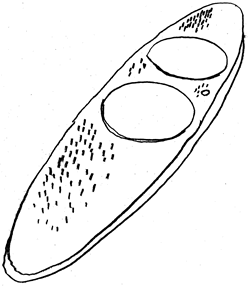
The pins represent a selection of analogue processes including multiplication, resonation and integration. I built it in Chicago about ten years ago, and so I have forgotten most of the ideas encapsulated within; furthermore, the original piece was lost to water damage in Baltimore. I do remember one design goal: it was to be a collection of modules that work without goals. At the time, I had just finished a deconstruction of the synthesizer known as the Shinth, which had no knobs and appeared as an open circuit board for performance by touching it. From the website of Foundation Daniel Langlois, the funders of the project:
The shinth is a neologism coined by the artist to describe an electronic device that neither indicates nor provides any mechanical control of its process. The shinth is a musical instrument stripped of its exterior, its protective envelope, thus revealing the circuit board. Rather than pressing on keys or twisting knobs, the user produces sounds by directly touching the circuits. For Blasser, the important thing is to expose the interior surface of bare circuits. Form and content are made equal here. Clearly, circuit benders question the pertinence of the exterior envelope of commercial electronic instruments, which supposedly serve to protect the user from an electric shock. According to Blasser, the only possible danger with the shinths is not to receive a shock, but to saturate sensitive areas of the instrument with an electric current that is too powerful. 7[7. From the “Peter Blasser: shinths” page on the Daniel Langlois website (Retrieved October 2015).]
With the Shinth, I began to build synthesizers inspired by circuit bending. 8[8. Circuit bending is the act of scrounging for old consumer items — often baby toys — and breaking them open, the art being to explore the circuit board with wires to bring about alternative sonic states — glitchy, sluggish or just plain noisy.] To continue this design work, I needed to curate “safe” touch nodes and re-encapsulate the circuit board within a protective wooden skin, pierced by brass pins that bring forth internal connections. Thus the case regained importance as an isolating factor, housing pins and nobs.
I can return to gaze at the Din Datin Dudero design on the computer, to recuperate some of its lost design ideas. It seems to be arranged into four modules. Each contains two smaller cells, exactly the same, that somehow affect each other in circular motion. Multiple analogue processes, such as multiplication and oscillation, combine in a single module. There is a whimsical nature as to the purpose of each, since they mostly introvert, like a sort of analogue missile guidance system for a schizophrenic war game. Beyond that, I can’t tell you what these modules do, because the Din Datin Dudero manifesto induced them as analogue for analogue’s sake, without goals, but seeking completeness through woven and rhizomal connections. 9[9. From the Wikipedia article on the philosophical concept of rhizomes: “Deleuze and Guattari use the terms ‘rhizome’ and ‘rhizomatic’ to describe theory and research that allows for multiple, non-hierarchical entry and exit points in data representation and interpretation. In [their 1980 work] A Thousand Plateaus, they oppose it to an arborescent conception of knowledge, which works with dualist categories and binary choices.”]
The Din Datin Dudero manifesto specifies three essential components — sandrodes, sh’mance and nobs. The brass pins are sandrodes, or androgynous nodes. They are both inputs and outputs, as most wires indeed are. The analogue processes connect to each other in loops, and these connections, polyvalent and androgynous, come forth to the exterior of the instrument.
Another layer of the manifesto specifies a contingent internal re-wiring system called the sh’mance. This is mostly digital, taking the analogue vibrations and de-siding them to ones and zeros in primitive memory blocks. These registers then inform multiplexers to make new connections among the pins. This has the same effect as connecting some pins with alligator clips, but internally, and controlled by signals.
A mansion is a solid state of butlers, lords, maids and stables in diurnal rhythms; a sh’mance is like a fourth-dimensional portal in and around the mansion to become different solid and jelly states, changing its architecture or hierarchy of animals.
The final part of the manifesto details the two giant and hairy nobs. One knows not what a nob does — it is not a knob known for mono-dimensional axes such as frequency or volume. Instead, a nob joins with the field of sandrodes by becoming an analogue process in itself. To bring this about, I designed two circuit ideas for torque gestures: one for capturing boundaries on a turn in direction and another for generating arbitrary steps within any rotation. There also seems to be an afterbirth idea tucked into the Din Datin Dudero circuit board, which on analysis and breadboarding 10[10. A breadboard is a plastic wafer laced with metal clips inside cavities, used for quickly testing electronic circuits.] does not work, due to improper circulation of feedback.
Nobsrine
Nobsrine. Another baroque analogue computer, with two nobs, to generate music out of the back-and-forth milking gestures of a young one.
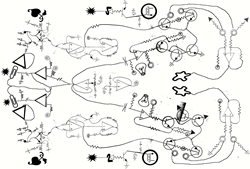
On observing my young one’s stereo milking, I extracted a nob circuit from the Din Datin Dudero for a new instrument (Fig. 2). I reckoned the boundary sampler would have the most effect as modulation source for simple triangle oscillators, and an envelope also generated by nob movement. The Nobsrine, first produced as paper circuit 11[11. The idea for paper circuits, a simple technique for making custom circuits, came originally from the commonsound listserv (now 4ms Company). A design is printed out on paper, with front and back mirrored and adjacent; it is creased and folded along this mirror line, and card-stock is glued in between. The front design shows where to pierce holes with a needle, and the back shows where to take inserted component leads, bend them, and join them with solder.] contains these features in binary divisions: for the two nobs, there are two oscillators that derive their pitch and envelope from clockwise and counter-clockwise movement (Fig. 3). To detect change in direction (clockwise to counter-clockwise or vice versa) a small capacitor feeds the nob voltage to a hysteresis circuit 12[12. Hysteresis, also known as positive feedback, senses any change in direction, to manifest a “0” or “1” transition for the direction.] that sends separate spikes to analogue switches, resulting in a very learnable sample-and-hold circuit. Likewise, to generate an envelope, a capacitor decouples the nob gesture, differentiating it into intensities of acceleration, separated by direction. It is silent when non-played.

The instrument turns itself off after a few seconds of non-playing. My young one taught me a most important lesson about power. First of all, know that a child will never switch an instrument off, causing its battery to eventually deplete. Second, consider an on-off toggle switch to control the main power of an instrument. Show a child how to turn it on, accompanied by a metallic click; the baby reaches over to make another click: off! The lesson is the same as the stereo milking: the interface component means a different thing to the purposeful mind than to the playful one. I intended to make a simple and useful power control. To my son, a toggle-as-toggle simply clicks as it goes back and forth — who cares if it uses no battery one way, and depletes it in the other? Its inherent sonic operation takes attention from that which it controls internally, the energization of a synthesizer circuit.
The answer to this primal physicality is a simple button and a more sophisticated internal switch — a circuit that turns itself off. The button triggers an active component, a MOSFET to energize the circuit. 13[13. A MOSFET, or Metal Oxide Semiconductor Field Effect Transistor, is a transistor with an insulated gate at a physical proximity close enough for an electrical field to trigger conduction in the main channel. It is often used for power circuit controls.]. Show a button-press to a child, thereby turning the instrument on, and the child will press it again to continue the on-ness; there is no wrong move. Furthermore, the instrument can keep itself on by shunting its sampling pulses through transistors to the MOSFET gate; by milking the nobs, the instrument maintains aliveness.
The Oval Interface
For many years I kept the Nobsrine prototype around, as a simple way to play with children and a physical manifestation of the nob-milking gesture. Its wooden box served it well, but now in seeking to produce it on a larger scale, I query its case design and ask what could it become.

I am drawn to bring back the original Din Datin Dudero as it prototyped a strong and unique manifesto, and its oval shape made it a deluxe interface. The shape brands well: the Din Datin Dudero page on my website boasts to be the first constructively oval web presence. I unearthed a simple drawing from my early Chicago years, a pencil sketch of a headband tiled with the Din Datin Dudero insignia — two large circles within an oval and a forest of little pins (Fig. 4). The remnants from routing an oval circuit board yield space for the small oval medallions of a headband; the formula for a successful brand includes these wearables and accessories that bolster the image of the main product.
Thinking of the oval strictly as an electronic analogy, there are unique uses for its thought pattern. In any oval, there are two types of curves: the long one and the short one (Fig. 5). Likewise in synthesizers, there are long and short modulations. The short one is within a module, such as the internal workings of an oscillator, its hysteresis loop and its negative integration loop 14[14. Integration, in the water analogy, is filling a bucket through a narrow pipe, so that it slowly hydrates and must eventually be emptied.]. In the Din Datin Dudero modules, short modulations could include the internal, hard-wired “lace” between elements of the module, such as in two oscillators that affect each other in a circular manner.
A connection from one module’s “output” to another’s “input” is a long modulation, contingent on the user’s patching or some large-scale plan. The two long and short “curves” of a synthesizer constitute two essential types of sandrode: intra and inter. Intra-sandrodes, within the module, stab unpredictably at the essential properties of electronic materials: transistor curves, capacitor granularities. Inter-sandrodes are the sites of mixing and folding between larger schemes, and more coded interfaces such as inputs and outputs: “two oscillators mix as the frequency modulation of a resonator,” for example.
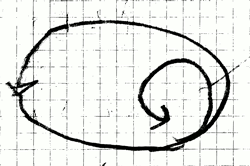
What does the oval shape offer as an external interface for electronics? Circuit boards usually take a rectilinear shape, because they are cheapest with straight lines and right angles; curves require extra routing and wasted circuit board. But many electronic components have circular form factors: knobs sweep a radius and jacks have little round holes. Fitting two big knobs inside a bigger oval creates all sorts of pockets to tuck other features in: a cloud of pins in the wings, an indicator light in the crescent between the circles.
The oval form suggests a cellular organism in shape, with nobs as dual nuclei; it is an analogue of the jelly machine’s simple workings. Then jelly machine is a metaphor for living processes, through alchemical romanizations, to electronic analogies — integration, multiplication, resonation, oscillation are electronic, chemical, living and ballistic elements of war, too. I watched the cellular analogy grow while designing the original Din Datin Dudero, but after building it I played it for other people who reminded me of a more powerful analogy: it looks like a surfboard.
The Surfing Analogy
At Smuggler’s Cove, the water looked like a giant pool of suds; it was all scramble, and too chaotic to harbour coherent waves. Bummed surfers headed back up the hill as we walked down it, others chilled on the rocks to watch the water heave whitely. As non-surfers, we headed out and found more driftwood and other things, ferried by the foam to the beach; we profited by finding flotsam, jetsam and interesting bits tucked into the caves. The way a surfer profits from chaos is by embracing it in “stormsurfing” — a great metaphor for analogue performance. On a gray day, there may be waves, coherent or sloppy; you paddle along and you just might catch one and improvise a ride back to shore.
The surfing analogy derives simply from the fact that the original Din Datin Dudero looked like a surfboard. I will now develop this analogy in respect to the three manifesto design points, and how it reflects upon analogue and electronic music. 15[15. I am indebted to my neighbour Jamie Holzgraf for explaining the subtleties of wind and tide in surfing, and for dropping the idea of “stormsurfing”. Also, to Ron Shalom for asking the question: “Is there a theory of electronic music?”]
Nodes
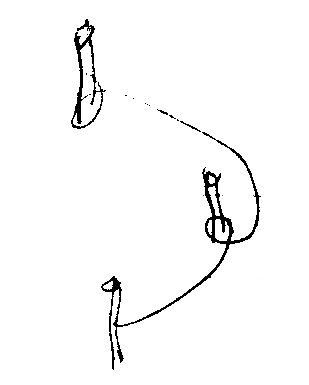
The terrain and how you weave your jeep through the coastal highways. Preferably open frame, the jeep allows a full assay of the surf sounds, water pounding on rocks or sizzling on sand. You smell pine saps at the different sites, gaining important clues of the temperature and humidity of the cliffs, all which affect the wind. Where you smell rotten seaweed, beware the chaotic scramble of detritus beaches. Or leave your wetsuit in the jeep and become a beachcomber of serendipitous odd things and flotsam-jetsam — important elements of electronic music. You find the perfect spot with a sense of exploration and flexibility as to your activities for that spot. Different locations on different days.
Sh’mance
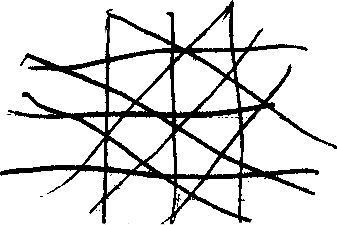
The multiplex mansions of the weather. A few bits for the phase of the moon, which interacts with the time of day — another few bits — to modulate the tides. The intensity of wind and its direction bite the weather more intensely, not to mention local factors, like shellfish and jellyfish populations. As a sixteen-bit number, there are 65536 different situations, resulting in all sorts of surf patterns: placid, undulating, breaking walls of water to treacherous scramble. In flat water you can paddle out far and admire the coastal range. In a good wave flow, you get to work, standing up and riding a melody home. In adverse conditions, again you admire — this time the spray from a vantage on the rocky beach. Interpreting the air-water weather, you improvise as surfer.
Nobs

The interface of your own physicality to the board. Here is the art of torqueing to shift your centre of gravity in response to myriad wave confluences beneath the board. You must respond with muscle memory but also with a sense of composition. You’ve memorized the directions to nob crags and devil’s cauldron by hiking the dry paths high above; do you feel their influence in the water as you bob? How do you rotate through intensities? Where is your sense of balance? We are surfers??!
The large furry nob has a particular role: to encourage the surfer’s open hand gesture. Electronic design often overlooks the articulation and tension of the hands that interface. A traditional, small knob encourages a tight and tense clasp of the fingers (Fig. 9), like a beachcomber that takes and mines little things. A surfer instead uses the hand as part of a whole body gesture, for balance and intuitive expression. One hand attacks, stabbing precisely; the other feels the fur and, as it rotates, loosely senses the resultant waveform balance. Only on the beach can there be such wide variety of scale, minuscule and oceanic.

Perhaps the deepest water analogy is the importance of current. The tides mark different heights, or potentials, on the shoreline, in response to phases of the moon. Surfers may consider this on the way to knowing the actual currents out there, in the water. The flow of water influences the waveshape much more than its static height.
Traditional analogue synthesis uses voltages, or potentials, as semaphores between modules. This reflects a desire to impress a sense of symbolic computing onto the synthesizer, to rationalize it. What happened to the other half of Ohm’s law, the direction and intensity of flow? Most of the important work inside synths uses currents — inside an oscillator, as current multipliers, as a result of exponentiation — encapsulated by a voltage buffer only at the very exterior. The intra-sandrode attempts to bring the emphasis on current interactions to the surface of the instrument as safe, but perhaps irrational sites of experimentation. The delight of the circuit bender is crossing currents and the resultant non-linear behaviour.
Fyrall, the On Button
Fyrall. A baroque analogue computer, available in kit form from Ciat-Lonbarde around 2005. Since discontinued, the name is repurposed as a new instrument manifesting a part of Din Datin Dudero.
Recently, I returned to the Din Datin Dudero design files, to resuscitate it again as a potential performance instrument. As I said, I found a selection of analogue processes organized into modules more whimsical than the typical VCA or VCO 16[16. A VCA (voltage controlled amplifier) performs a single task: modulate the amplitude of an input signal by another signal. Likewise, a VCO (voltage controlled oscillator) performs the singular duty of generating a waveform with its frequency controlled by another.] by virtue of their interwovenness. By that, I mean that a typical module contains two smaller cells of the same design, where the output of one feeds into the other, and around so in a loop. This eliminates a goal-centred need for chaining the modules together in narrative, linear structures, since they twitter quite interestingly on their own.

The recent analysis, with the vantage of my design mind wiped clean by years of forgetting, discloses a particular lack of goals. Traditional processes such as oscillation or multiplication become blurred with others, as does the line between input and output. Perhaps I will bring back all these designs in the future, but for now I chose to focus on fully developing the nob circuits, especially since the first focus, the Nobsrine, is conceptually ready to go as a production instrument. For the second nob extraction, I repurposed a smaller name, “Fyrall”, from an extinct instrument that carried many of the properties present in this new idea — nobs that generate various stepped melodies, ramping envelopes and sawtooth waveforms.
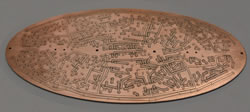
The Fyrall essentially takes each nob signal (a changing voltage), segments it into arbitrary steps and holds it as control voltage for a cluster of oscillators. The step size is voltage controlled by an array of transistor math that also conveniently generates error currents (Fig. 10). Although it sounds like bad design, the error signal is fertile ground; here it represents the nob drift between steps, to feed an amplifier circuit. The result is a bunch of performance-controlled, stepped pitches with fine-grain amplitude control.
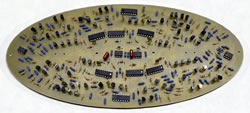
I made the prototype Nobsrine as a paper circuit, but for the Fyrall I chose to prototype with my new favourite technique: isolation routing on a CNC cutter. Using a fine bit I cut through the copper foil of a fiberglass circuit board (Fig. 11) to isolate the traces from each other. The CNC machine also performs drilling and routing to finish the board. For these nob circuits that do a lot of analogue voltage sampling, the higher impedance of true circuit board is right to hold the levels without leaks. On the Nobsrine, I had to take some sampling pins and elevate them into the air so as not to touch the paper, but there were no such worries on the Fyrall.
Seizing upon an oval form factor, I made the prototype in this shape (Fig. 12). When converted to production design in the final edit, it will shrink a bit, but retain roughly the same flow. A prototype is an interesting place for creativity — the CNC machine cuts the board, but I must hand-work the wooden envelope. I explore various types of plastic and wooden knob designs, node placement and speaker acoustics.

The “on” button received further refinements since its introduction in the Nobsrine. That instrument tended to stay on, and this needed an analysis and fix. The nob circuits feed pulses into transistors that keep the gate of the MOSFET charged. But the comparators that generate these pulses will glitch when their power is starved, and so they have a habit of generating all sorts of dying spasms, keeping the MOSFET “alive”. The art of listening to power-on and power-off signatures will tell a lot about an instrument and it has eco-compositional interest 17[17. Eco-composition, in the context of electronic music, might include the reveal and awareness of energy usage for electronic instruments, so their turning on and off is a critical focus, as well as various liminal, starved energy states. A starved energy state occurs when current the main power for an instrument is limited in current.], but in this case, “off” needs to be a decisive kill, accomplished by another MOSFET in Schmitt de-trigger configuration. 18[18. A Schmitt trigger uses positive feedback, or hysteresis, to insure that digital transitions, from on to off, are decisive. It is often the fundamental basis of interfacing with digital inputs. A de-trigger configuration, means that instead of being active in the on state, the Schmitt trigger is active in the off state, preventing the glitched and mistaken revival pulses from keeping the instrument alive.] This ordeal of circuit re-working goes to show that the simplest elements, such as an “on” button, take a lot of creative technology to work (Fig. 13).
Analogue Pitch Relationships and the Sh’mance
Initially I designed the Nobsrine, as well as the Fyrall, without a Sh’mance. However, I realized both could become more compositionally interesting in pitch set if a minimal Sh’mance were applied to the pitch modulation and step size controls. I also felt a need to complete the three design points of the original Din Datin Dudero manifesto, and the 4000 series multiplexer 19[19. An analogue multiplexer is a two-way switch that usually connects a single node to a multiplicity of others, controlled by a digital address.] chips consume very little current, in sum less than one milliampere; in contrast a speaker amplifier usually consumes a minimum of twenty milliamperes.
A Sh’mance is easily conceived, but analogue inputs and outputs are difficult to prepare to receive each other in any combination. The Sh’mance logic is simple: some 4051 multiplexers and some logic turned on its head to clock out scrambled addresses. The “rungler” concept by Rob Hordijk is a concise definition: using the analogue signals themselves as digital inputs, they become a primitive genetic code in eight or sixteen bits, that are then converted back into analogue voltages for use as modulation of those original analogue signals. 20[20. Muffwiggler forum user “Richard” posted an excerpt of documentation written by Rob Hordijk, “What the $#%$ is a Rungler?,” that attempts to explain the rungler. See Rob Hordijk’s perspectives on “Designing Instruments for Electronic Music,” also published in this issue of eContact!]
The Sh’mance does not generate scrambled voltages, but it connects the circuit to itself in different combinations. The multiplexers connect the primary output — sampled voltages from the nob circuit — to the primary input — the frequency controls of the oscillators. On the original Din Datin Dudero, the Sh’mance was a much broader scope, potentially connecting anything to anything else, circuit bending fashion. Here, it has a more guided purpose: to generate more than one set of pitch progressions by inversion, and scaling step size differently — the nob circuit itself has an input that controls step size. The important feature is that the inputs have two sides — verso and inverso 21[21. Verso and inverso reflect the essential property of the differential amplifier and its two inputs. Actually a differential amplifier also has two outputs so it likewise has a verso and inverso there too; the duality of inputs and outputs leads to the art of differential amplifiers with high tolerance for common-mode noise. But a simple exponential converter, à la Serge Synthesizer, uses only one output, so tracing back to the two inputs, one causes more current to flow with a higher voltage, and the other causes less to flow with a similar voltage — verso and inverso.] — so the Sh’mance easily inverts any pitch progression.

In his 1961 treatise, Twentieth-Century Harmony: Creative Aspects and Practice, Vincent Persichetti details every pitch relationship between the twelve tones of Western equal temperament, within the octave and also in wider spacings. 22[22. I first encountered Vincent Persichetti’s work in high school band, playing Serenade for Solo Tuba, and also Masquerade for Band. The type of composer that ends up in high school band repertoire is usually an undercard compared with those in the symphony hall, but the exposure to atonal and almost freely through-composed music was nevertheless valuable to the high school mind of this author.] His theory desires to relieve modern music from any prejudices 23[23. Here’s an example of a harmonic prejudice: traditional Bach-style counterpoint strictly forbids the diminished sixth, which was a racialization against so-perceived Moorish music.] as to proper pitch sequences, and in serialist style, blow the twelve-note octave open to any possible combinations.
Take the differential exponential converter as a simple rule: in any voltage difference, when transposed, the output will maintain the proper pitch-perceived interval; furthermore, the converter has both verso and inverso inputs, so inversion is natural (Fig. 14). So twisting these nobs and choosing their manifestation by the Sh’mance is an analogue of Persichetti’s twentieth-century harmony and the equality of intervals. The electronic orchestration range exceeds that of tubas and piccolos, but instead of thinking in timbre — woodwinds, strings and brass — we think about modulations on the pins, either by touch or wire. Persichetti’s modulation uses a pitch pivot to enigmatically change pitch centres, but the Sh’mance aids motivic development, or composition, of pitch classes.
Worms
A customer recently asked me if I would return to the simple brass pins that served as interface on my earlier instruments. I have experimented with other types of patching systems, such as brass screws, eventually settling on the banana plug as a convenient and easily colour-coded interface. 25[25. Johnson brand banana plugs have ten colours: red, white, black, purple, grey, yellow, orange, blue, brown and green. In another instrument, the Plumbutter, I purposed this full spectrum to signify different types and functions of nodes.] The brass node has advantages for an intuitive system like the Din Datin Dudero, in discouraging scientific thinking, instead desiring a creative weaving of constellations. Also, the brass pins are handsome and a little bit mysterious, clustered like trees with a rhizomal spacing.

The brass pins wedge into a wooden case, which may have slight conductivity, due to the living, moist nature of the wood. As a synthesynthesist using this material, I’ve encountered and explored its hidden properties in my work. 26[26. In third grade, my science project was about the breakability of different types of wood as they bend; this project directly influenced an electronic organ design using the flexure of wooden bars as a gesture controller. In fourth grade, my science project was on the flammability of woods.] In this case (pun intended), the wood acts as an antenna to modulate the instrument by external electric fields. Everyone knows that copper wires convey our mains electricity to heat our food or light our spaces, but also a good deal of the current from the mains field leaks out into the air and watery ground around us. Any synthesizer, with improper grounds, will manifest this as various buzzes and impure warbles, but it is a special challenge when the whole case is an electric-touch sensor. This is why the original Din Datin Dudero had a strip of ground jacks: connect it to a good ground and the sounds are pristine and clean. The problem also dissipates when battery powers the device; then, the ground “floats”.
On tour with the original Din Datin Dudero, I bought worms at a Pennsylvania gas station. That night, playing at a show in Toronto, I used the worms as living patch cords:
The worms seem to like being electrically stimulated. It’s like we humans can perceive all sorts of senses — like tasting cinnamon and sage — but in the ground all a worm gets to do is bump into roots and indifferently crawl around stinky grubs. With the Din Datin Dudero, we can induce all sorts of new sensations in the worms — new waveshapes at new and unfelt speeds make me feel like jonquil or Three Kings, Bible bouquet or mandrake. They squirm into action as all the pins are stimulating them and they crawl around touching things together and making it go crazy. 27[27. Excerpt (slightly edited) from the author’s Din Datin Dudero tour notes (April 2004).]
Since the Dudero limits current on all of its pins, it cannot shock the worms. I noticed a particularly interesting feedback pattern began when a worm coiled around a few pins of lower activity, then reached out to another of high activity, recoiled, but reached out again for its stimulation, in a rhythmic pattern, tapping and releasing over and over.
Since worms are so wet inside, they are nothing but a great bundle of dirt-eating, current-sensing nerves. Martin Howse describes “worm coding” as:
When working with active materials such as forest or graveyard earth (Paris, Media Mediums, Père-Lachaise Cemetery) radio, magnetic and ultrasonic impulses are transmitted into the earth and the distorted signals flowing through the earth, perhaps recoded by worms… (Howse 2015)
Howse works at the artful intersection of code (symbols, data) and life (organization in entropy). His gamut of performances are actually an inspiring mix of laboratory science and ancient alchemy, in good faith that worms may make electrical connections within the earth, unfettered by industrial noises. 28[28. See Martin Howse’s “Gallery” in eContact! 16.4 — Experimental Practices and Subversion in Sound for more on his “life coding” work.] On the Din Datin Dudero, with captive fishing bait worms as my worker bees, I can focus this interaction as “worm bending” with the cybernetic interface of sandrodes coursing signals directly through the worms’ bodies.
Parasites
The new Nobsrine and Fyrall feature battery power and built-in speakers for safe and spontaneous play with young ones and worms. To power sensitive analogue circuitry presents a design challenge alongside speaker amplifiers, which easily inject current spikes into the power supply. A battery is even more susceptible to these signals because it has resistances and current limits on its energy supply. To an extent, these parasitic signals 29[29. A parasitic signal results from some circuit element affecting itself, often through another element, in an uncontrolled manner introducing oscillations and noise. It is related to the paradox wave, because the oscillations do not arise from logical machinations of transistors, instead depending on the very nature of the silicon in an irrational configuration.] can become part of the living composition of the instrument, but the designer must explore remediations as well. I employed two in the new designs:
- Parallel power circuits controlled by separate MOSFETs for the analogue and the speaker amplifiers. In combination with good decoupling capacitors, the MOSFETs act as diodes and limit some of the highest frequency crosstalk on the power supplies.
- A special chopper supply for the virtual ground, which feeds as a reference to all the oscillators. A plain virtual ground supply consists of a simple voltage divider across the power supply, a decoupling capacitor and perhaps a buffer. However, the speaker amplifiers will bend slow current dips into the power supply, crossing the MOSFETs into the analogue circuit, where they dip this virtual ground as well. The result is bendy “clowntown” tones emanating from the oscillators. The tricky remediation is to use sampling pulses on the virtual ground, to hold a level in capacitor, and through a buffer it remains impervious to power supply dips.
Both these remediations require extra circuitry, and perhaps in the case of the chopper supply, more kinks in the living circuit board that results. The original Fyrall circuit featured a “spesal cuck,” or current switch on the power supply, that became an important whole-instrument modulation, allowing it to current-starve 30[30. No power supply is ideal, with infinite current. Current starving exploits this fact by limiting the current to a level that is lower than the circuit requirements, thus allowing its various elements to influence and communicate with each other over the power supply. It usually introduces electronic parasites.] itself and increase parasitic signals exponentially. Likewise, treating the virtual ground as a sort of analogue entity takes it from behind the scenes and makes it vulnerable to circuit bending as a node, allowing another whole-instrument modulation.
Speakers require an acoustic space to voice them. Thus, a case should be as cavernous as possible, to give its sound depth. The space within has a spectral response that gives the instrument personality; these parasitic resonances do not sound when listening to the instrument over external amplification.

The original Din Datin Dudero, almost four feet long, contained a nest of long wires to distribute the pins to the wings. I try to preserve this sense of spacing, with two large nobs close to the centre flanked by wing-shaped forests of pins (Fig. 16). In shrinking it down to about sixteen inches, I have the opportunity to curate this node spread as etched copper traces rather than the capricious wire nest. The assembly time chore of wire soldering becomes a science of noise at design time. Nodes of one type — current emphasis, modulation, pulses — desire exposure to those of other types. 31[31. Bruno Latour’s actor-network theory speaks of non-human subjects that desire, as part of a contingent definition of the social. What better to express this than androgynous pins that interact with others as well as the person who touches them, and extending out to the expectations and impatient nose snorts of an audience that wanted to hear techno!] Also, different sections of the instrument should butt up against each other. Luckily the circuit board is already somewhat jumbled on the inside, due to the various interpretations of chip pinning 32[32. Chip pinning is the organization of how the inputs and outputs, of say an op-amp, come out to the linear row of metal contacts on its exterior.] and the general nature of two-dimensional layout of a non-dimensional circuit idea, so it’s easy to scramble the node placement in the wings.

However, in shrinking the designs down to surface mount components 33[33. Surface mount components, without wire leads, facilitate extended and automated production, but they are very small and impractical for creative prototyping. In contrast, through-hole components have long wire leads, providing deluxe flexibility to experiment with.] for production, the circuit board gained extra empty space in the wings, where only pins and their traces seat. In this extra space, I propose to add a few extra “charms” — twittering-machine 34[34. For the original illustration of the “twittering machine”, see Paul Klee’s 1922 watercolour of the same name.] circuits adapted from the original Din Datin Dudero. They run quite happily on their own, generating a plexus of complicated waveforms, by virtue of their interwoven modulations across multiple sub-components. In the Nobsrine and Fyrall, one does not immediately hear these charms working, but their pins sit waiting to be touched or wired to the main sound-producing pins, influencing them like a parasite, with alternative vibrations (Fig. 17).
Since the charms each have a complicated system of woven modulations, I prototyped them as paper circuits. In these prototypes, I work out the optimal configuration of interlocking connections, so the sub-components prevent each other from becoming simple oscillations. Thus the goal is a spread of frequencies, available across and within multiple pins. In porting them from the original Din Datin Dudero, I only updated the oscillator designs to mimic those that already exist within the new models — a habit of making everything feel like the same family, just with more or less convoluted interconnects.
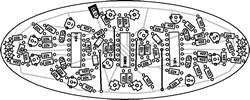
Methinks these charms may become nice little instruments on their own, so I intend to foster their development as fully documented paper circuits. A paper circuit shares well if it runs well on its own, it responds to touch, and components may be swapped out for different values, especially in the capacitors. Those are the essences of the charms for their purpose in Nobsrine and Fyrall, so they become a birdstone 35[35. Birdstone is an object that kills two birds with one stone, or accomplishes two tasks. The art is to not subjugate one task to another, and serve them equally well. Do not force a birdstone, but accept it when it happens.] used for both verifying the Din Datin Dudero parasites and as useful building blocks in an open-source, DIY instrument, installation or workshop. I like to release them in series, providing variations on a couple of the original parasites, with different types of oscillators, allowing for a collection of different types working together. Paper circuits are great for a group of people, like a workshop environment, where the end product is like a social simulation of the Din Datin Dudero, with a variety of twittering machines (Fig. 18).
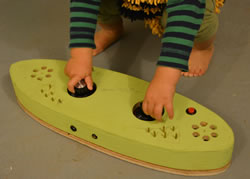
The design ambitions of the oval synthesizer are low-hanging fruit — the organic and novel form factor, a forest of friendly brass pins, big nobs graspable by young ones (Fig. 19). Bitter and strange pulp shrouds the analogue seeds within, hanging high on the tree of whimsy. Power circuitry requires constant compensation, sandrodes need calibration for equal emphasis on input and output, and their placement depends on the bouquet of other sandrodes they desire to react with. The simple gestures of nob milking generate baroque amounts of transistor math to afford simple compositional patterns — back-and-forth corners, interval series. These transistor apparatus, in turn, generate new potential for timbre modulation, which inspire further node spreads. The Din Datin Dudero is an open question about enigmatic twittering machines within.
Bibliography
Davis, Miles and Quincy Troupe. Miles: The autobiography. New York: Simon and Schuster, 1989.
Howse, Martin. “[Gallery] Martin Howse.” eContact! 16.4 — Experimental Practices and Subversion in Sound / Pratiques sonores expérimentales et subversives (March 2015). https://econtact.ca/16_4/howse_gallery.html
Latour, Bruno. Reassembling the Social: An Introduction to actor-network-theory. Oxford: Oxford University Press, 2005.
Persichetti, Vincent. Twentieth-Century Harmony: Creative Aspects and Practice. New York: W.W. Norton, 1961.
Wikipedia contributors. “Rhizome (philosophy).” Wikipedia: The Free Encyclopedia. Wikimedia Foundation Inc. http://en.wikipedia.org/wiki/Rhizome_(philosophy) [Last accessed November 2015]
Social top